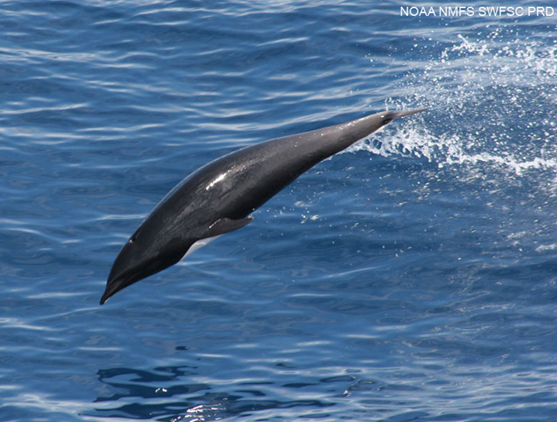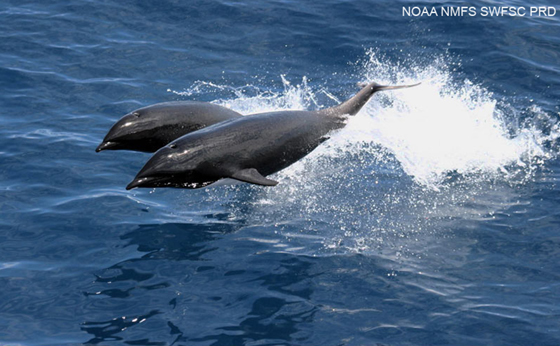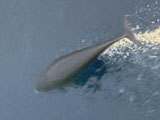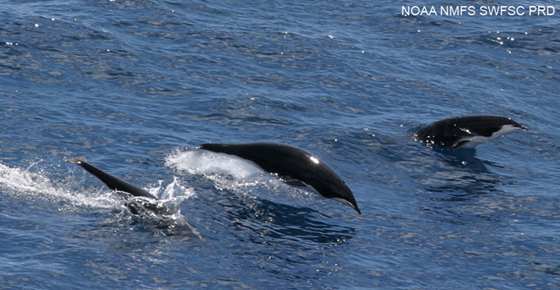Northern Right Whale Dolphin (Lissodelphis borealis)
Status | Taxonomy | Species Description | Habitat | Distribution |
Population Trends | Threats | Conservation Efforts | Regulatory Overview |
Key Documents | More Info
 Northern Right Whale Dolphin (Lissodelphis borealis) Photo: NMFS Southwest Fisheries Science Center |
|
Did You Know? · Northern right whale dolphins are capable of long leaps and bounces spanning more than 20 ft (7 m) over the surface of the water. |
|
 Northern Right Whale Dolphin (Lissodelphis borealis) Photo: NMFS Southwest Fisheries Science Center |
Status
MMPA - Northern right whale dolphins, like all marine mammals, are protected under the MMPA.
Taxonomy
Kingdom: Animalia
Phylum: Chordata
Class: Mammalia
Order: Cetacea
Family: Delphinidae
Genus: Lissodelphis
Species: borealis
Species Description
Northern right whale dolphins are members of the delphinid family and the subfamily Lissodelphinae. They are approximately 6.5-10 ft (2-3 m) in length and weigh 130-250 lbs (60-115 kg). Males are generally larger than females. This species has a slender streamlined body with a short beak, sloping forehead, slim "tailstock", and small "flukes". Their slender body may make them appear smaller than their actual size. They are the only species of dolphin without a "dorsal" fin found in the North Pacific Ocean. These dolphins are also recognized by a mostly shiny black coloration on the dorsal side and a contrasting less-visible white ventral side. Variants with a "swirled" pattern have been reported (Shirihai and Jarrett 2006). Calves and juveniles have a muted dark gray-brownish to cream coloration.
The southern right whale dolphin is another species of right whale dolphin that appears similar to the northern right whale dolphin. Both species are within the same genus: Lissodelphis. The two species differ slightly in physical size, features, coloration pattern, and geographic distribution. Southern right whale dolphins prefer similar cold temperate waters in the Southern Hemisphere and have a circumpolar distribution. They also are generally larger in size and have more white on their underside, giving them a more striking appearance than their northern counterparts.
Northern right whale dolphins are usually found in large tight social groups (herds) of about 100-200 individuals, but have been occasionally seen in larger groups of up to 2,000-3,000 animals. They are sometimes seen in mixed schools associated with at least 14 species of other cetacean species such as Pacific white-sided dolphins and short-finned pilot whales.
Northern right whale dolphins are fast swimmers and make low-angled graceful leaps out of the water. They have been reported to reach sustained speeds of 16 miles per hour and bursts of 22 mph (26-35 km/hour) (Leatherwood et al. 1988). When moving slowly at the surface, this species can be inconspicuous and show very little of their body. Occasionally, they have been known to engage in "breaches", flops, side-slaps and "lobtails" at the surface. Groups of individuals will sometimes "bowride" when associating with other cetaceans, but they are also known to avoid vessels.
Northern right whale dolphins are capable of diving and holding their breath for up to 6.5 minutes to feed on small mesopelagic fish (e.g., "myctophids") and cephalopods (e.g., squid) in the deep scattering layer. They have 37-54 pairs of small conical teeth in each jaw that are useful for grasping their prey.
Northern right whale dolphins become sexually mature and begin breeding around 9 years of age. After a gestation period of about a year, females give birth to a single calf that is about 2.5-3.5 ft (0.8-1 m) long every two or more years. Most calves are born during the summer, peaking in July and August. Their estimated lifespan is 42 years or longer.
 Northern Right Whale Dolphin (Lissodelphis borealis) Photo: Janice Waite, NOAA |
Habitat
Northern right whale dolphins are endemic to the deep, cold temperate waters of the North Pacific Ocean. Northern right whale dolphins are generally found in waters over the continental shelf and slope that are colder than 66° F (19° C).
Distribution
The abundance and distribution of northern right whale dolphins varies based on oceanographic conditions and seasons. They are widely distributed across the North Pacific Ocean from northern Baja California (Mexico) to the Gulf of Alaska, Kamchatka (Russia), and Japan. North-south movements have been documented based on water temperature changes, with the movements south during the colder winter and autumn months, and north during the warmer spring and summer months.
Population Trends
For management purposes, northern right whale dolphins inhabiting U.S. waters have been placed in a California/Oregon/Washington stock. Off the west coasts of California, Oregon, and Washington it is estimated that there are between 16,000-21,000 northern right whale dolphins. In the entire North Pacific Ocean, scientists estimate a population of about 68,000. There are insufficient data for this species to determine the population trends.
 Northern Right Whale Dolphin (Lissodelphis borealis) Photo: NMFS Southwest Fisheries Science Center |
Threats
Northern right whale dolphins have been incidentally taken as bycatch in fisheries such as driftnets, gillnets, and purse seines. During the 1970s and 1980s, in the pelagic driftnet fisheries targeting squid had high incidental mortality rates that may have depleted local and regional stocks, but these fisheries have since been shut down by international law. Today, northern right whale dolphins are still taken in gillnets and are sometimes directly killed in the Dall's porpoise harpoon drive fishery off of Japan.
Conservation Efforts
The International Union for Conservation of Nature and Natural Resources (IUCN's) Red List of Threatened Species ![]() considers this species "Lower Risk Least Concern."
considers this species "Lower Risk Least Concern."
In 1997, NMFS implemented the Pacific Offshore Cetacean Take Reduction Plan, which requires the use of pingers and 6-fathom net extenders in the CA/OR drift gillnet fishery to reduce bycatch of cetaceans, including northern right whale dolphins. The Pacific Offshore Cetacean Take Reduction Team continues to met and recommend measures to further reduce bycatch and achieve MMPA goals.
Regulatory Overview
This species is protected under the Marine Mammal Protection Act of 1972, as amended.
Key Documents
(All documents are in PDF format.)
| Title | Federal Register | Date |
|---|---|---|
| POCTRP Final Rule | 62 FR 51805 | 10/03/1997 |
| Stock Assessment Reports | n/a | various |
- NMFS Southwest Fisheries Science Center Northern Right Whale Dolphin Species Information
- NOAA's National Marine Sanctuaries
- Ocean Biogeographic Information System (OBIS-SEAMAP) Northern Right Whale Dolphin Species Profile

- Convention of Migratory Species Northern Right Whale Dolphin Species Information

- MarineBio.Org Northern Right Whale Dolphin Species Information

- International Union for Conservation of Nature (IUCN) Northern Right Whale Dolphin Species Information

References:
- Reeves, R. R., P. A. Folkens, et al. (2002). Guide to Marine Mammals of the World. New York, Alfred A. Knopf. p. 418-421.
- Leatherwood, S., R. R. Reeves, et al. (1988). Whales, Dolphins, and Porpoises of the Eastern North Pacific and Adjacent Arctic Waters: A Guide to Their Identification. New York, Dover Publications, Inc. p. 209-212.
- Shirihai, H. and B. Jarrett (2006). Whales, Dolphins and Other Marine Mammals of the World. Princeton, Princeton University Press. p. 223-225.